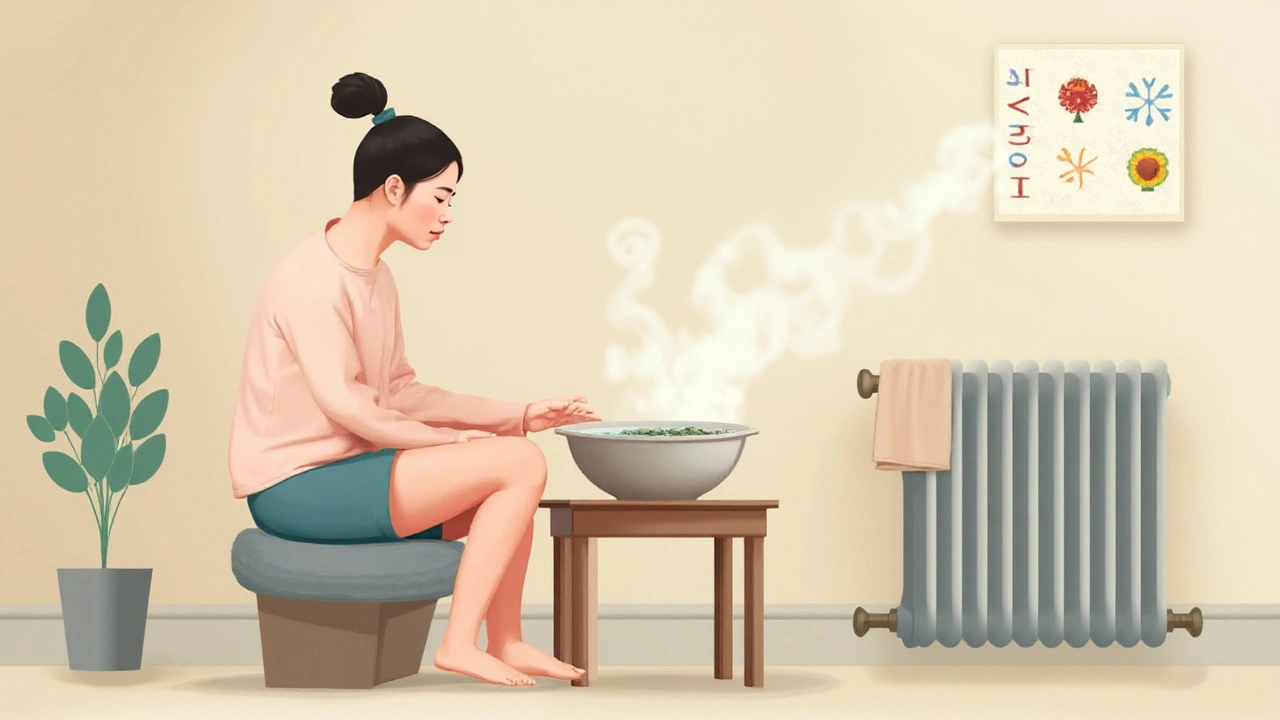Key Takeaways
- Allergies can keep your sinuses inflamed all year, leading to chronic sinusitis.
- IgE‑mediated reactions, nasal polyps, and impaired mucociliary clearance are the main bridges.
- Diagnosing the allergy link requires skin tests, blood panels, and imaging.
- First‑line treatments are antihistamines, intranasal corticosteroids, and allergen immunotherapy.
- Lifestyle changes-air filtration, nasal irrigation, and trigger avoidance-cut down flare‑ups dramatically.
Understanding Allergies and Chronic Sinusitis
Allergy‑induced chronic sinusitis is a persistent inflammation of the sinus cavities driven by allergic mechanisms. While acute sinusitis clears within weeks, the allergic form lingers, often for months or years, because the immune system never fully calms down.
The central player in most allergic reactions is ImmunoglobulinE (IgE). When you inhale an allergen-pollen, dust‑mite particles, or mould spores-IgE antibodies on mast cells recognize it, releasing histamine and other mediators that cause swelling of the nasal lining.
That swelling narrows the sinus ostia, the tiny doorways that let mucus drain. When drainage stalls, mucus builds up, creating a perfect environment for bacterial overgrowth and prolonged inflammation, which clinicians label chronic sinusitis.
How Allergic Reactions Trigger Sinus Inflammation
Three physiological steps turn a harmless allergen into sinus pain:
- Sensitisation: Your immune system produces IgE specific to the allergen.
- Late‑phase response: Hours after exposure, eosinophils flood the nasal tissue, releasing proteins that keep the lining swollen.
- Impaired mucociliary clearance: The cilia that normally sweep mucus out become sluggish, so secretions linger.
When the lining stays inflamed, nasal polyps often develop. These soft, painless growths further obstruct airflow, creating a vicious cycle.
Year‑Round Allergens: The Hidden Culprits
Most people picture spring pollen, but many allergens are present all year:
- House dust mites - thrive in bedding and carpets, releasing proteins that trigger IgE responses. \n
- Indoor mould - grow on damp walls, especially in older Manchester homes.
- Pet dander - tiny skin flakes from cats and dogs that linger on furniture.
- Cockroach allergens - common in city flats, their shed skin and droppings are highly allergenic.
If you suffer from perennial symptoms-runny nose, pressure, or headache on a rainy day-you’re likely reacting to one of these year‑round triggers.

Diagnosis: Spotting Allergy‑Driven Sinusitis
Doctors use a combination of history, tests, and imaging:
- Clinical questionnaire: Details on symptom timing, known triggers, and family history of atopy.
- Skin‑prick test (SPT): Small amounts of standard allergens are introduced into the skin; a wheal >3mm suggests sensitisation.
- Serum IgE panel: Measures specific IgE levels to common indoor allergens; values above 0.35kU/L are considered positive.
- CT scan of sinuses: Shows mucosal thickening, ostiomeatal obstruction, and the presence of polyps.
When the tests align-high IgE, positive SPT, and radiologic evidence of sinus blockage-clinicians confirm the allergy‑sinus link.
Treatment Pathways: Medications and Immunotherapy
The goal is two‑fold: calm the allergic inflammation and restore normal sinus drainage.
| Therapy | Primary Action | Typical Onset | Key Side‑Effects |
|---|---|---|---|
| Antihistamines | Block histamine receptors, reducing sneezing and watery discharge | 30minutes-2hours | Dry mouth, mild drowsiness (first‑gen) |
| Intranasal corticosteroids | Suppress local inflammation, shrink polyps, improve mucociliary function | 3-7days | Nasal irritation, occasional nosebleeds |
| Allergen immunotherapy | Modifies immune response, reducing IgE over years | 6-12months for noticeable benefit | Local swelling at injection site, rare systemic reactions |
For most patients, the first step is a daily intranasal corticosteroid spray (e.g., fluticasone). If symptoms persist despite optimal spray technique, adding a second‑generation antihistamine (loratadine or cetirizine) helps control the histamine surge.
When medication alone can’t keep the inflammation at bay-especially in people with high IgE levels or multiple nasal polyps-allergen immunotherapy becomes the disease‑modifying option. Subcutaneous injections are given weekly for the first 3months, then monthly; sublingual tablets are an alternative for dust‑mite or grass pollen.
Lifestyle Hacks to Keep Sinus Passages Clear
Even the best drugs can’t beat consistent environmental control:
- Air filtration: Use HEPA filters in bedrooms; change them every 6months.
- Dust‑mite bedding: Encase mattresses and pillows in allergen‑proof covers; wash weekly at 60°C.
- Humidity control: Keep indoor humidity below 50% to discourage mould growth.
- Nasal irrigation: A daily saline rinse (250ml) clears mucus and reduces allergen load.
- Pet management: Keep cats and dogs out of the bedroom; bathe them weekly.
Combine these habits with a short‑term antihistamine before exposure (e.g., a walk in a park with high pollen) to blunt the acute spike.
When to See a Specialist: Surgery and Advanced Care
If you develop extensive nasal polyps or you’ve tried maximal medical therapy for 12weeks without relief, an ear‑nose‑throat (ENT) surgeon may recommend functional endoscopic sinus surgery (FESS). This minimally invasive procedure reopens blocked drainage pathways and removes polyps, allowing medications to work more effectively.
Post‑operative care often includes a short course of oral steroids followed by long‑term intranasal corticosteroids and, if you’re a candidate, immunotherapy to prevent regrowth.
Remember, surgery isn’t a cure for the allergy itself; it merely restores anatomy. Ongoing allergy management remains essential to keep the sinuses clear for the long haul.

Frequently Asked Questions
Can seasonal allergies cause chronic sinusitis?
Seasonal allergies can start a cycle of inflammation, but for chronic sinusitis to persist year‑round you usually need a perennial trigger-like dust mites or mould-that keeps the immune system activated continuously.
How long does it take for nasal steroids to work?
Most patients notice reduced congestion within 3‑7days, but full reduction of polyp size may require 4‑6weeks of consistent use.
Is immunotherapy safe for people with asthma?
Yes, when asthma is well‑controlled. In fact, many studies show immunotherapy improves both allergic rhinitis and asthma control, reducing the need for inhaled steroids.
What home tests can confirm a dust‑mite allergy?
A simple in‑home kit can collect dust samples for a lab‑based IgE assay. While not as definitive as a skin‑prick test, a positive result (>0.35kU/L) usually correlates with clinical symptoms.
Can I avoid surgery by using stronger meds?
In many cases, aggressive medical therapy-including a combination of high‑dose nasal steroids, short courses of oral steroids, and immunotherapy-can shrink polyps enough to skip surgery. However, if the drainage pathways remain blocked, surgery offers the most reliable long‑term relief.


Praveen Kumar BK
September 21, 2025 AT 23:32Everyone should start by acknowledging that chronic sinusitis caused by allergies isn’t just a nuisance; it’s a public‑health concern that demands disciplined lifestyle changes. Dust‑mite exposure in the bedroom can be mitigated by encasing mattresses in impermeable covers, washing bedding at temperatures above 60 °C, and vacuuming with a HEPA filter. Moreover, regular nasal irrigation with isotonic saline can physically remove allergens and reduce mucosal swelling, thereby lowering the need for pharmacologic escalation. Ignoring these basic hygiene steps is tantamount to neglecting one’s duty to personal well‑being and, by extension, community health. A strict regimen of nasal corticosteroids-applied correctly using a spray technique that directs the mist toward the middle meatus-maximizes anti‑inflammatory effects while minimizing systemic absorption. Finally, individuals must refrain from the casual attitude that “a little sniffle” is harmless; persistent inflammation can lead to polyps, which often require surgical intervention if left unchecked. In summary, disciplined environmental control, correct medication use, and responsible self‑monitoring are non‑negotiable for anyone suffering from allergy‑induced chronic sinusitis.
Viji Sulochana
September 26, 2025 AT 14:38i think swapping out old pillows for hypoallergenic ones can really cut down on dust mite triggers, especially if you wash them regularly.
Stephen Nelson
October 1, 2025 AT 05:45Oh fantastic, another miracle cure that works in a week.
Fredric Chia
October 5, 2025 AT 20:52Clinical guidelines recommend intranasal corticosteroids as first‑line therapy; adherence to dosage instructions is essential for efficacy.
Hope Reader
October 10, 2025 AT 11:58Honestly, if you’ve tried everything and still sneeze like you’re in a snowstorm, maybe it’s time to see an ENT – just saying 😊
Marry coral
October 15, 2025 AT 03:05Stop ignoring the mold in that damp corner, it’s feeding your sinuses and you’re acting like it’s nothing.
Emer Kirk
October 19, 2025 AT 18:12you need to keep the humidity below 50% or else you’ll have mould growing everywhere it will make your sinus worse
Roberta Saettone
October 24, 2025 AT 09:18Adding a second‑generation antihistamine to your daily intranasal steroid regimen can smooth out the histamine spikes that occur after allergen exposure, especially during high‑pollen days.
Sue Berrymore
October 27, 2025 AT 20:38Take this as a challenge: commit to a 30‑day nasal rinse routine and track your symptom scores; you’ll likely see a noticeable drop in congestion and pressure.
Jeffrey Lee
October 31, 2025 AT 07:58While the article is thorough, it fails to mention that many patients definately benefit from a short course of oral steroids before considering surgery.
Ian Parkin
November 3, 2025 AT 19:18It is commendable that the piece highlights both pharmacologic and environmental strategies, thereby offering a comprehensive roadmap for sufferers.
Greg McKinney
November 7, 2025 AT 06:38One could argue that the emphasis on immunotherapy is overblown; many patients do just fine with optimized nasal sprays and lifestyle tweaks.
Dawna Rand
November 10, 2025 AT 17:58Great rundown! 🌟 Remember, a simple step like daily vacuuming with a HEPA filter can make a massive difference in dust‑mite load.
Effie Chen
November 14, 2025 AT 05:18The suggestion to keep pets out of the bedroom aligns with the evidence that dander accumulation is a major perennial trigger.
rohit kulkarni
November 17, 2025 AT 16:38One must first contemplate the ontological relationship between the immune system and the mucosal frontier, for it is within this delicate interface that the drama of allergic sinusitis unfolds; the IgE molecules, like vigilant sentinels, patrol the nasal epithelium, ever‑ready to raise the alarm at the slightest intrusion of dust mite proteins, pollen fragments, or fungal spores, thereby unleashing a cascade of histamine, leukotrienes, and prostaglandins that conspire to engorge the vascular beds and swell the lining; this edema constricts the ostiomeatal complex, impeding the mucociliary clearance that ordinarily serves as the sinuses’ self‑purifying mechanism, and when this clearance falters, mucus stagnates, creating a fertile breeding ground for opportunistic bacteria, which in turn amplify the inflammatory milieu, perpetuating the cycle of chronicity; meanwhile, the late‑phase response, characterized by eosinophilic infiltration, deposits cytotoxic granules that further erode tissue integrity, nudging the development of polyps, those soft proliferations that act as additional physical barriers to airflow; it is therefore no surprise that a multipronged therapeutic approach-encompassing intranasal corticosteroids to dampen the immediate inflammatory surge, antihistamines to blunt the histaminergic component, and allergen immunotherapy to recalibrate the immune system’s aberrant reactivity-offers the most rational pathway to remission; nevertheless, pharmacotherapy alone is insufficient without addressing the environmental reservoir of allergens, which demands rigorous interventions such as HEPA filtration, humidity control below the critical 50 % threshold, and the use of allergen‑impermeable bedding encasements, all of which serve to starve the immune system of the stimuli that fuel its hyperactivity; finally, the role of surgical intervention, namely functional endoscopic sinus surgery, should be viewed not as a cure for the allergic predisposition but as a restorative measure that reestablishes anatomical patency, thereby augmenting the efficacy of medical regimens and reducing the risk of recurrent obstruction; thus, a harmonious synthesis of diligent environmental stewardship, judicious medication adherence, and, when indicated, surgical correction constitutes the optimal strategy for those ensnared in the relentless grip of allergy‑induced chronic sinusitis.
RONEY AHAMED
November 21, 2025 AT 03:58That detailed breakdown makes it clear why a combined approach is the only sensible way forward.